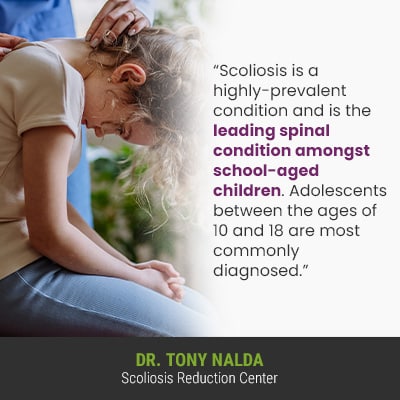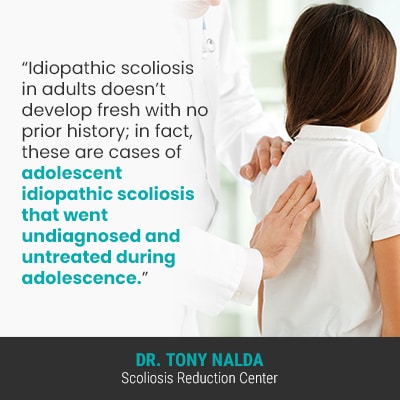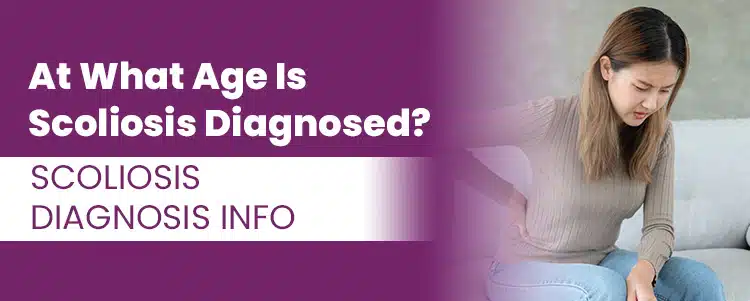Scoliosis is primarily regarded as a child condition, but many people don’t realize that it can be diagnosed at any age. From congenital to infantile, early-onset juvenile to adolescent and adult scoliosis, it’s important to understand how scoliosis is diagnosed.
The nature of scoliosis necessitates a customized treatment approach because it ranges widely in severity, there are different types of scoliosis, and the condition can affect all ages; however, scoliosis is most commonly diagnosed between the ages of 10 and 18 as adolescent idiopathic scoliosis.
Due to the condition’s progressive nature, when scoliosis is first diagnosed isn’t always aligned with its initial onset.
When is Scoliosis Diagnosed?
Scoliosis is a structural spinal condition that involves the development of an unnatural lateral (sideways) spinal curve, with rotation, making it a 3-dimensional condition, and it’s diagnosed when it becomes noticeable enough to warrant testing and a diagnosis.
Scoliosis is diagnosed when an unnatural spinal curve, with rotation, and a minimum Cobb angle measurement of at least 10 degrees is detected; however, scoliosis is progressive, meaning its nature is to worsen over time.
Scoliosis ranges widely in severity from mild to moderate and severe to very severe, and condition severity is determined by a patient’s Cobb angle:
- Mild scoliosis: Cobb angle measurement of between 10 and 25 degrees
- Moderate scoliosis: Cobb angle measurement of between 25 and 40 degrees
- Severe scoliosis: Cobb angle measurement of 40+ degrees
- Very-severe scoliosis: Cobb angle measurement of 80+ degrees
As you can see by the different Cobb angle measurements, scoliosis ranges widely in severity, and this is a key factor when it comes to when scoliosis is diagnosed.
The more severe a condition, the more likely it is to cause noticeable symptoms and effects, and in many cases of mild scoliosis, the condition’s signs can be so subtle that a diagnosis isn’t reached until conditions have progressed into the moderate stage, when the condition’s effects tend to become more noticeable.
So let’s now break down the different age groups affected by scoliosis, with a focus on the most common condition types.
What Age is Scoliosis Most Common?

Scoliosis is a highly-prevalent condition and is the leading spinal condition amongst school-aged children. Adolescents between the ages of 10 and 18 are most commonly diagnosed.
Adolescent idiopathic scoliosis is the condition’s most common type so is most frequently diagnosed, and the idiopathic designation means not clearly associated with a single-known cause.
While we don’t fully understand the cause of idiopathic scoliosis, we do know how to treat it, and we do know that it’s growth and development that triggers its progression.
Now, it’s important to understand that especially in young patients who still have growth yet to go through, scoliosis can be particularly challenging to detect and diagnose, and this is because scoliosis doesn’t become compressive until skeletal maturity has been reached.
It’s compression of the spine and its surrounding muscles and nerves that causes the majority of condition-related pain, and while no one wants to experience it, pain tells us something is wrong with the body, so when a condition isn’t overly painful, it can make early detection a challenge.
So while scoliosis is most commonly diagnosed between the ages of 10 and 18, that doesn’t mean that the time of diagnosis reflects the condition’s initial onset, but rather when it becomes noticeable enough to warrant further testing that can lead to a diagnosis.
Let’s now address other age groups affected.
Congenital Scoliosis
When it comes to how early scoliosis can be detected, congenital scoliosis is a rare form affecting approximately 1 in 10,000, but it shows that scoliosis can also be diagnosed in babies.
Congenital scoliosis develops in utero due to a malformation within the spine itself; this can involve vertebrae (bones of the spine) failing to separate into distinct vertebral bodies at the time of formation, or when one or more vertebrae are misshapen.
While congenital scoliosis can be diagnosed at birth, sometimes this can be more related to the fact that spinal abnormalities that develop in utero are commonly accompanied by additional malformations within the body.
Sometimes, congenital scoliosis isn’t diagnosed until growth is occurring, triggering its progression and making it more noticeable.
Infantile Scoliosis
Infantile scoliosis refers to scoliosis that develops between the ages of 6 months old and 3 years of age.
Some cases of infantile scoliosis resolve on their own, but there is no way of knowing which will resolve and which will progress with growth, so close monitoring is important.
The next age group affected are juveniles.
Juvenile Early-Onset Scoliosis
When it comes to juvenile early-onset scoliosis, this involves children between the ages of 3 and 10, and this type is more likely to progress with growth well into adulthood, if left untreated, or not treated proactively.
Remember, growth can equal progression, which is why being proactive with treatment is so beneficial, and while there are no treatment guarantees, early detection and intervention does increase chances of treatment success.
The next age group are adolescents, which we’ve discussed is the most common age scoliosis is diagnosed in.
An interesting fact about scoliosis is that although it’s more commonly diagnosed in children, the actual rate of scoliosis increases with age, so let’s take some time to now focus on scoliosis being diagnosed in adults.
Diagnosing Adult Scoliosis
The two most common types of scoliosis to be diagnosed in adults are idiopathic and degenerative.
When it comes to understanding the challenge behind early detection of scoliosis, idiopathic scoliosis in adults is the ideal place to start.

Idiopathic scoliosis in adults doesn’t develop fresh with no prior history; in fact, these are cases of adolescent idiopathic scoliosis that went undiagnosed and untreated during adolescence.
While it can seem difficult to understand how an adolescent can live with an unnaturally-curved spine for so many years and not be diagnosed until adulthood, this is quite common.
Remember, scoliosis doesn’t become compressive until adulthood, so this is when it tends to become painful, and while postural deviation is the main symptom that leads to a diagnosis in children, pain is the main condition indicator in adults.
The unfortunate reality is had these patients been diagnosed and treated during adolescence, their spines would be in far better shape than they are by the time they come to me for a diagnosis and treatment.
So adult idiopathic scoliosis is the perfect example of how the time of diagnosis often has little to do with its initial development.
The second most common type to affect adults is degenerative, and this is caused by natural age-related spinal degeneration, so is most often diagnosed in adults over the age of 40, and is also more common in women than men: understood as a result of changing hormones and bone-density levels associated with menopause.
And this is where it gets interesting; the actual rate of scoliosis increases with age, although it’s more commonly diagnosed in children, and this is due to age-related spinal degeneration coming into play.
Scoliosis in adolescents is estimated at a rate of approximately 2 to 4 percent, but some studies have found the rate of scoliosis in adults to be between 12 and 20 percent, with the rate of scoliosis in adults over the age of 60 increasing to a staggering 68 percent.
Conclusion
So at what age can you get scoliosis: at any age.
While scoliosis is most commonly diagnosed as adolescent idiopathic scoliosis, between the ages of 10 and 18, the condition can affect babies, adults, and every age in between.
It’s important to understand, however, that early detection of scoliosis isn’t always easy, and as a progressive condition, the longer a condition is left undiagnosed and untreated, the more it’s likely to progress, and the more noticeable its effects are likely to become.
Here at the Scoliosis Reduction Center®, the majority of my patients are adolescents with moderate scoliosis because many conditions that are mild don’t produce functional deficits or noticeable symptoms, and it’s not until they progress to moderate that their signs and symptoms become noticeable.
So when a patient’s scoliosis is first diagnosed often has little to do with its initial onset, and is more related to progression and when the condition becomes noticeable enough to warrant a trip to the doctor for screening and further testing.
Knowing the often subtle signs and symptoms of scoliosis in children can help achieve early detection, and when met with proactive treatment, there are fewer limits to what can be achieved.
As scoliosis progresses, this means the spine’s unnatural curve is increasing in size, as are the condition’s uneven forces, and their effects, and the spine is becoming more rigid: making it less responsive to treatment.
The best time to start treatment is as close to the time of diagnosis as possible, and while this is true of most progressive conditions, it is especially the case with scoliosis as the time of diagnosis doesn’t always reflect the condition’s initial development.




